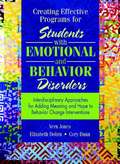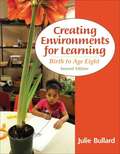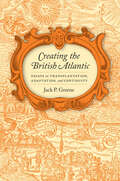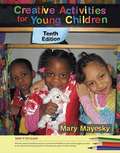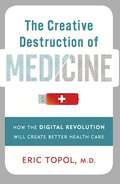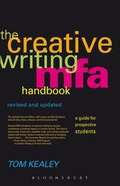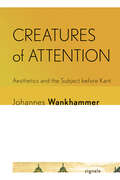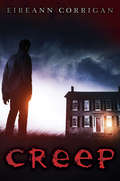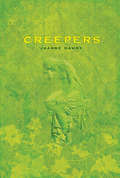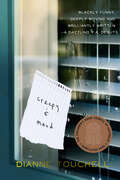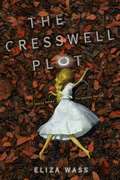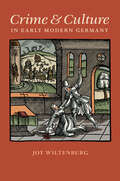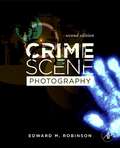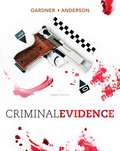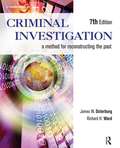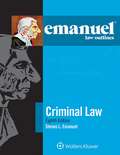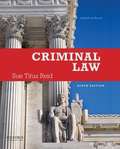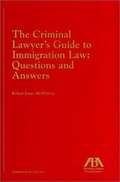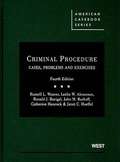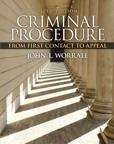- Table View
- List View
Creating Effective Programs for Students with Emotional and Behavior Disorders
by Cory Dunn Elizabeth Dohrn Vern JonesThis exiting new book provides special educators, school psychologists, and others responsible for programs for students serving students with EBD with specific methods, supported by sound research and proven by practice, for developing or improving services to this student population. While several current books provide excellent discussions concerning characteristics of students with EBD and describe some methods that have been effective in helping these students improve their behavior, this is the only book to provide a thorough, comprehensive examination of concepts and strategies needed to effectively develop and implement a program for this student population. special educators, school psychologists, therapists.
Creating Environments for Learning: Birth to Age Eight (Second Edition)
by Julie BullardThis book is designed for college courses taught at institutions that focus on quality early childhood learning environments and curriculum.
Creating Literacy Instruction For All Children In Grades Pre-K to 4
by Thomas G. GunningIn response to today's need to tailor instruction for the lower grades (PreK-4), this comprehensive, practical guide gives aspiring and practicing professionals the methods and techniques they need to become highly effective teachers who are well equipped to help all students become proficient readers and writers. Creating Literacy Instruction for All Children in Grades Pre-K to 4 features lesson plans for virtually every major literacy skill or strategy, abundant lists of recommended children's reading, helpful student strategies, numerous reinforcement activities, and real-life illustrations of exemplary teaching, all designed to help teachers incorporate today's most effective teaching methods and techniques into their literacy teaching.
Creating Minds: An Anatomy of Creativity as Seen Through the Lives of Freud, Einstein, Picasso, Stravinsky, Eliot, G
by Howard GardnerThe man who revolutionized our understanding of intelligence now gives us a pathbreaking view of creativity, along with riveting portraits of seven figures who each reinvented an area of human endeavor. Understanding their diverse achievements not only sheds light on the nature of creativity but also elucidates the “modern era”-the times that formed them and that they in turn helped to define.
Creating the British Atlantic: Essays on Transplantation, Adaptation, and Continuity (Early American Histories)
by Jack P. GreeneSet mostly within an expansive British imperial and transatlantic framework, this new selection of writings from the renowned historian Jack P. Greene draws on themes he has been developing throughout his distinguished career. In these essays Greene explores the efforts to impose Old World institutions, identities, and values upon the New World societies being created during the colonization process. He shows how transplanted Old World components—political, legal, and social—were adapted to meet the demands of new, economically viable, expansive cultural hearths. Greene argues that these transplantations and adaptations were of fundamental importance in the formation and evolution of the new American republic and the society it represented.The scope of this work allows Greene to consider in depth numerous subjects, including the dynamics of colonization, the development and character of provincial identities, the relationship between new settler societies in America and the emerging British Empire, and the role of cultural power in social and political formation.
Creative Activities For Young Children (Tenth Edition)
by Mary MayeskyCREATIVE ACTIVITIES FOR YOUNG CHILDREN, 10th Edition, is a terrific book filled with fun, creative, and easy-to implement activities for young children. You'll be encouraged to exercise your own creativity, as well as learn how to help young children do the same. Hundreds of activities, up-to-date research, recipes, finger plays, information on how to select children's books, and more make this book an invaluable resource for you and others planning to work creatively with children across the curriculum--and one you'll want to keep for use throughout your professional career.
The Creative Destruction of Medicine: How the Digital Revolution Will Create Better Health Care
by Eric TopolWhat if your cell phone could detect cancer cells circulating in your blood or warn you of an imminent heart attack? Mobile wireless digital devices, including smartphones and tablets with seemingly limitless functionality, have brought about radical changes in our lives, providing hyper-connectivity to social networks and cloud computing. But the digital world has hardly pierced the medical cocoon. Until now. Beyond reading email and surfing the Web, we will soon be checking our vital signs on our phone. We can already continuously monitor our heart rhythm, blood glucose levels, and brain waves while we sleep. Miniature ultrasound imaging devices are replacing the icon of medicine--the stethoscope. DNA sequencing, Facebook, and the Watson supercomputer have already saved lives. For the first time we can capture all the relevant data from each individual to enable precision therapy, prevent major side effects of medications, and ultimately to prevent many diseases from ever occurring. And yet many of these digital medical innovations lie unused because of the medical community's profound resistance to change. In The Creative Destruction of Medicine, Eric Topol--one of the nation's top physicians and a leading voice on the digital revolution in medicine--argues that radical innovation and a true democratization of medical care are within reach, but only if we consumers demand it. We can force medicine to undergo its biggest shakeup in history. This book shows us the stakes--and how to win them.
Creative Writing MFA Handbook: A Guide for Prospective Graduate Students (2nd Edition)
by Tom KealeyRevised and Updated! The Creative Writing MFA Handbook guides prospective graduate students through the difficult process of researching, applying to, and choosing graduate schools in creative writing. The handbook includes profiles of fifty creative writing programs, guidance through the application process, advice from current professors and students including George Saunders, Aimee Bender, Tracy K. Smith, and Geoffrey Wolff, and the most comprehensive listings of graduate writing programs in and outside the United States. The handbook also includes special sections about Low-Residency writing programs, Ph. D. programs, publishing in literary journals, and workshop and teaching advice. In a remarkably concise, user-friendly fashion,The Creative Writing MFA Handbook answers as many questions as possible, and is packed with information, advice, and experience. This second edition updates and builds upon the first edition, which was published in 2005 to great acclaim and contains a vastly expanded ranking of current creative writing programs.
Creatures of Attention: Aesthetics and the Subject before Kant (Signale: Modern German Letters, Cultures, and Thought)
by Johannes WankhammerCreatures of Attention excavates the early modern prehistory of our late modern crises of attention. At the threshold of modernity, philosophers, scientists, and poets across Europe began to see attention as the key to autonomous agency and knowledge. Recovering the philosophical and literary works from eighteenth-century Germany in which "attention," "subject," and "aesthetics" developed their modern meanings, Johannes Wankhammer examines control over attention as the cultural technique underpinning the ideal of individual autonomy. Aesthetics, founded by Alexander Baumgarten as a science of sense perception, challenged this ideal by reframing art as a catalyst for alternative modes of selfhood and attention. While previous scholarship on the history of attention emphasized the erosion of subjectivity by industrial or technological modernization, Wankhammer asks how attention came to define subjectivity in the first place. When periodically recurring crises of attention threaten the coherence of the subject, the subject comes undone at the very seams that first sutured it together. Creatures of Attention offers the first systematic study of a foundational discourse on attention from 1650 to 1780. Presenting pre-Kantian aesthetics as a critique of the Enlightenment paradigm of strained attention, the book offers a fresh perspective on poetics and aesthetics in eighteenth-century Germany.
Creep
by Eireann CorriganThe haunting tale of a family that moves into a house... and finds that someone -- or something -- does NOT want them there.Olivia is curious about the people moving into 16 Olcott Place. The last family there moved out in the dead of night, and the new family, the Donahues, has no idea why. Olivia becomes fast friends with Janie Donahue . . . so she's there at the house when the first of the letters arrives:--I am the Sentry of Glennon Heights. Long ago I claimed 16 Olcott Place as levy for my guardianship. The walls will not tolerate your trespass. The ceilings will bleed and the windows will shatter. If you do not cease your intrusion, the rooms will soon smell of corpses.--Who is the Sentry? And why does the Sentry want the Donahues out of the house badly enough to kill? As Olivia and Janie explore the house, they find a number of sinister secrets . . . and as they explore their town, they find a hidden history that the Sentry wants to remain hidden forever. You can lock the doors. You can close the windows. But you can't keep the Sentry out. . . .
Creepers
by Joanne DahmeFrom moving to a new house to making new friends and preparing for high school, life for the new girl in town can be unsettling. But thirteen year-old Courtney is unprepared for how creepy life in Murmur, Massachusetts turns out to be. Her ivy-covered house overlooking the antiquated cemetery next door is one thing, but Courtney finds herself thrust into a full-fledged haunted adventure after meeting Christian and Margaret Geyer, a strange father and daughter with unfinished family business. The body of their ancestor, Prudence, has gone missing from beneath her ivy-carved tombstone and must be returned to its final resting place in order to break the spell that looms over Courtney's house. To add to the suspense and help solve the mystery, authentic documents and photographs are set at the beginning of each chapter pertaining to Murmur, Courtney's house, and the infamous cemetery. Will Courtney uncover the secret lurking within the dark, dank underbelly of her ivy-covered basement?
Creepy & Maud
by Dianne TouchellHilarious and heartbreaking, Creepy & Maud charts the relationship between two social misfits, played out in the space between their windows. Creepy is a boy who watches from the shadows keenly observing and caustically commentating on human folly. Maud is less certain. A confused girl with a condition that embarrasses her parents and assures her isolation. Together Creepy and Maud discover something outside their own vulnerability — each other's. But life is arbitrary; and loving someone doesn't mean you can save them. Creepy & Maud is a blackly funny and moving first novel that says; 'You're ok to be as screwed up as you think you are and you're not alone in that.'
The Cresswell Plot
by Eliza WassThe woods were insane in the dark, terrifying and magical at the same time. But best of all were the stars, which trumpeted their light into the misty dark. Castella Cresswell and her five siblings???Hannan, Casper, Mortimer, Delvive, and Jerusalem??? know what it's like to be different. For years, their world has been confined to their ramshackle family home deep in the woods of upstate New York. They abide by the strict rule of God, whose messages come directly from their father. Slowly, Castley and her siblings start to test the boundaries of the laws that bind them. But, at school, they're still the freaks they've always been to the outside world. Marked by their plain clothing. Unexplained bruising. Utter isolation from their classmates. That is, until Castley is forced to partner with the totally irritating, totally normal George Gray, who offers her a glimpse of a life filled with freedom and choice. Castley's world rapidly expands beyond the woods she knows so well and the beliefs she once thought were the only truths. There is a future waiting for her if she can escape her father's grasp, but Castley refuses to leave her siblings behind. Just as she begins to form a plan, her father makes a chilling announcement: the Cresswells will soon return to their home in heaven. With time running out on all of their lives, Castley must expose the depth of her father's lies. The forest has buried the truth in darkness for far too long. Castley might be their last hope for salvation.
Crime and Culture in Early Modern Germany (Studies in Early Modern German History)
by Joy WiltenburgWith the growth of printing in early modern Germany, crime quickly became a subject of wide public discourse. Sensational crime reports, often featuring multiple murders within families, proliferated as authors probed horrific events for religious meaning. Coinciding with heightened witch panics and economic crisis, the spike in crime fears revealed a continuum between fears of the occult and more mundane dangers.In Crime and Culture in Early Modern Germany, Joy Wiltenburg explores the beginnings of crime sensationalism from the early sixteenth century into the seventeenth century and beyond. Comparing the depictions of crime in popular publications with those in archival records, legal discourse, and imaginative literature, Wiltenburg highlights key social anxieties and analyzes how crime texts worked to shape public perceptions and mentalities. Reports regularly featured familial destruction, flawed economic relations, and the apocalyptic thinking of Protestant clergy. Wiltenburg examines how such literature expressed and shaped cultural attitudes while at the same time reinforcing governmental authority. She also shows how the emotional inflections of crime stories influenced the growth of early modern public discourse, so often conceived in terms of rational exchange of ideas.
Crime Scene Photography (Second Edition)
by Edward M. RobinsonCrime Scene Photography, Second Edition covers the general principals and concepts of photography, while also delving into the more practical elements and advanced concepts of forensic photography. Edward Robinson assists the reader in understanding and applying essential concepts in order to create images that are able to withstand challenges in court. The first part of the book deals with the basic theory and science of photography required to take superior photographs, and covers topics such as composition, exposure, focus, depth of field, and flash techniques. The second part of the text deals specifically with the challenges of photographing a crime scene, including instructions on how to document bodies and wounds, traffic accident photography, underwater photography and aerial photography. In the latter portions of the text, the author turns to digital theory and its advantages and disadvantages. * Over 600 full color photographs, also electronically available on the companion website * Two new chapters on 'The History of Forensic Photography,' and 'Digital Image Processing of Evidentiary Photography' * Includes an Instructor website with lecture slides, practical exercises, a test bank and image collection * An essential reference for crime scene photography, including topics such as Composition, the Inverse Square Law, Court Cases affecting photography, Digital Image Processing, and Photogrammetry * Required reading by the Crime Scene Certification Board of the International Association for Identification (IAI) for all levels of certification
Criminal Cities: The Postcolonial Novel and Cathartic Crime (Cultural Frames, Framing Culture)
by Molly SlavinWhy does crime feature at the center of so many postcolonial novels set in major cities? This book interrogates the connections that can be found between narratives of crime, cities, and colonialism to bring to light the ramifications of this literary preoccupation, as well as possibilities for cultural, aesthetic, and political catharsis.Examining late-twentieth- and twenty-first-century novels set in London, Belfast, Mumbai, Sydney, Johannesburg, Nairobi, and urban areas in the Palestinian West Bank, Criminal Cities considers the marks left by neocolonialism and imperialism on the structures, institutions, and cartographies of twenty-first-century cities. Molly Slavin suggests that literary depictions of urban crime can offer unique capabilities for literary characters, as well as readers, to process and negotiate that lingering colonial violence, while also providing avenues for justice and forms of reparations.
Criminal Evidence (Eighth Edition)
by Thomas Gardner Terry AndersonWhat makes evidence admissible or inadmissible in court? You'll know the answer once you read CRIMINAL EVIDENCE: PRINCIPLES AND CASES, 8th Edition. Whatever your future career in the justice system, this book outlines all you need to know about criminal evidence and its use. Packed with stories and cases as well as the most up-to-date legal information available, it's the most relevant and engaging resource of its kind.
Criminal Investigation: A Method For Reconstructing the Past (Seventh Edition)
by James W. Osterburg Richard H. WardThis text presents the fundamentals of criminal investigation and provides a sound method for reconstructing a past event (i. e. , a crime), based on three major sources of information -- people, records, and physical evidence. Its tried-and-true system for conducting an investigation is updated with the latest techniques available, teaching the reader new ways of obtaining information from people, including mining the social media outlets now used by a broad spectrum of the public; how to navigate the labyrinth of records and files currently available online; and fresh ways of gathering, identifying, and analyzing physical evidence.
Criminal Law: Cases, Materials, and Lawyering Strategies
by David Crump Neil P. Cohen John T. Parry Penelope PetherThis casebook contains all of the subjects that ought to be covered in a first course in Criminal Law. The elements of crimes, actus reus and mens rea receive thorough coverage. The basic crimes, including homicide, sexual assault (or rape), theft, and related offenses, are there. The book covers multiple party crimes and preparatory offenses. Sentencing receives a major chapter. And the justification and legality of the criminal law, including constitutional limits on crime definition and the relationship between crimes, harm, and morals, are all covered.
Criminal Law and Its Processes: Cases and Materials (Ninth Edition)
by Sanford H. Kadish Stephen J. Schulhofer Rachel E. BarkowThis teaching guide helps law student students establish a solid foundation in the processes of criminal law and understanding of the problems within. This revised edition has enhanced details on group criminality, international human rights, human trafficking etc.
Criminal Law (Emanuel Law Outlines): Eighth Edition
by Steven EmanuelThe most trusted name in law school outlines, Emanuel Law Outlines were developed while Steve Emanuel was a student at Harvard Law and were the first to approach each course from the point of view of the student. Invaluable for use throughout your course and again at exam time, Emanuel Law Outlines are well-correlated to all major casebooks to help you to create your own outlines. Sophisticated yet easy to understand, each guide includes both capsule and detailed explanations of critical issues, topics, and black letter law you must know to master the course. Quiz Yourself Q&As, Essay Q&As, and Exam Tips give you ample opportunity to test your knowledge throughout the semester and leading up to the exam. Every title in the series is frequently updated and reviewed against new developments and recent cases covered in the leading casebooks. Emanuel Law Outlines provide a comprehensive breakdown of the law, more sweeping than most, for your entire study process. For more than thirty years, Emanuel Law Outlines have been the most trusted name in law school outlines. Here s why: Developed by Steve Emanuel when he was a law school student at Harvard, Emanuel Law Outlines became popular with other law students and spawned an industry of reliable study aids. (Having passed the California bar as well, Steve Emanuel is now a member of the New York, Connecticut, Maryland, and Virginia bars. ) Each Outline is valuable throughout the course and again at exam time. Outline chapters provide comprehensive coverage of the topics, cases, and black letter law covered in the course and major casebooks, written in a way you can easily understand. The Quiz Yourself Q&A in each chapter and the Essay Q&A at the end provide ample opportunity to test your knowledge throughout the semester. Exam Tips alert you to the issues that commonly pop up on exams and to the fact patterns commonly used to test those items. The Capsule Summary an excellent exam preparation tool provides a quick review of the key concepts covered in the course. The comprehensive coverage is more sweeping than most outlines. Each Emanuel Law Outline is correlated to the leading casebooks. Every title is frequently updated and reviewed against new developments and recent cases covered in the leading casebooks. Tight uniformity of writing style and approach means that if you use one of these guides, you can be confident that the others will be of similar quality.
Criminal Law, Ninth Edition
by Sue Titus ReidOffering a unique modified case approach, Criminal Law, Ninth Edition, uses a wide sampling of federal and state statutes and cases to provide students with a comprehensive and contemporary introduction to the field. This ninth edition features the most recent relevant court decisions, especially those of the U.S. Supreme Court, along with current events and updates, where available, on topics retained from the previous edition.
The Criminal Lawyer's Guide to Immigration Law: Questions and Answers
by Robert James McwhirterSet up in a unique question and answer format, this concise guide focuses on the criminal lawyer's most common questions about immigration law and representing noncitizens.
Criminal Procedure: Cases, Problems and Exercises (4th edition)
by Russell L. Weaver Leslie W. AbramsonThe fourth edition contains thought-provoking problems, and is designed to encourage classroom discussion, and help students effectively learn criminal procedure principles. Ideally suited for a one-semester course, this casebook contains all the essential decisions without being overwritten or so massive as to be unwieldy. in addition, the new edition is completely up-to-date containing the latest decisions from the United States Supreme Court, as well as problems based on important lower court decisions. Criminal Procedure: Cases, Problems and Exercises is unique because the authors actively seek to place students in situations that they are likely to encounter in practice, and asks students to think about how they might handle those situations (e. g. , what does a lawyer do when asked to represent a client at a lineup?). for this new edition, the authors have added a significant number of new problems. They have also added important cases from the United States Supreme Court's recent terms. (American Casebooks)
Criminal Procedure: From First Contact to Appeal (Fifth Edition)
by John L. WorrallThis comprehensive text uses a real world focus to cover all of criminal procedure, from first contact to appeal. Criminal Procedure: From First Contact to Appeal, 5e is a comprehensive introduction to criminal procedure, from first contact with the police, all the way through to appeal. The text is divided into five parts: (1) Introduction; (2) Search and Seizure; (3) Interrogations, Confessions, and Identification Procedures; (4) The Beginnings of Formal Proceedings; and (5) Trial, Conviction, and Beyond. The latter two topics are rarely covered in conventional criminal procedure books, particularly at the level of detail found in this text. This book presupposes no legal expertise, connects criminal procedure cases to the real world through innovative pedagogy, and encourages students through numerous decision making exercises to be critical thinkers by putting them in the position of judge. Teaching and Learning Experience This book presents a comprehensive introduction to criminal procedure, thoroughly presenting basic legal concepts and issues in a conversational written style and tone. It provides: Real World Focus: The text contains actual legal documents and excerpts from official policy manuals of police departments and other criminal justice agencies around the United States Clear, up-to-date coverage: Sequentially organized text is laden with the latest court cases and practical examples and illustrations Outstanding Pedagogical Features: Provides students with tools to master key concepts and content
